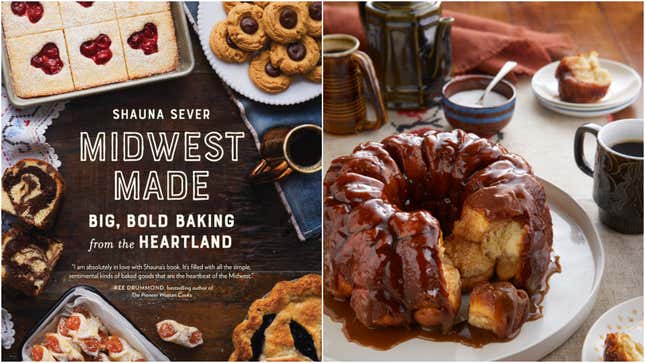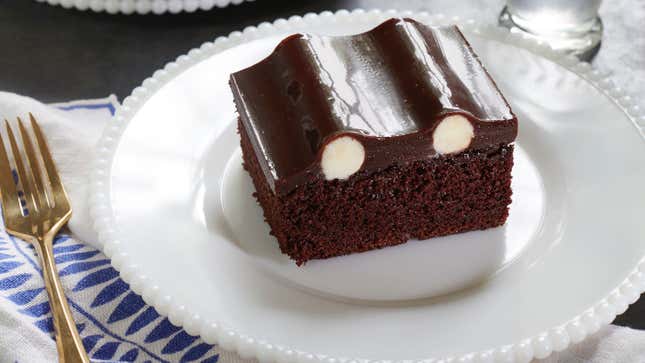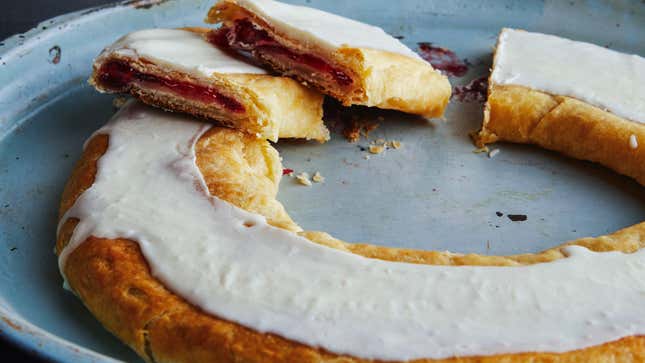
Midwest Made: Big, Bold Baking From The Heartland is a dangerous book. Its recipes call for enormous quantities of butter and sugar. And if you leave anything you bake from it on the kitchen counter, the finished product will pull you into its vortex and compel you to cut off one more sliver, then another, then another, until a good-sized chunk is gone. That’s a lot of power to ascribe to a lemon bundt cake, but that’s what happened in my kitchen this month, multiple times.
Shauna Sever, the writer who concocted these recipes, isn’t an inherently evil person, I don’t think. Her stated intentions are pure: She wants to share the food of her homeland. Her story is similar to that of a lot of people who grow up in the Midwest. They leave as young adults to explore the rest of the country—California, in Sever’s case—and then, somehow, end up right back where they started from. Only now they see the Midwest from the perspective of an adult and it’s... different.
In California, Sever writes, she never thought she thought much about where she came from, but Illinois lingered in her subconscious in the form of the family Christmas cookie recipe or her mom’s cherry shortcake, which she insisted on making, per the recipe, with canned filling, despite the fresh cherries at farmers markets all over the Bay Area.
Once she returned to the Chicago suburbs, she writes, “I planned to reexamine my midwestern roots and show them to my kids the best way I knew how—by firing up my oven.” She canvassed her friends for recipes, went on road trips to visit bakeries with legendary specialties, and delved through old church and community cookbooks. “Exchanging recipes with a midwesterner is a bit like playing therapist—deeply buried memories are revealed, and everyone takes home extra reading material.”
Defining the boundaries of the Midwest is a delicate exercise. Sever has decided that it ranges from western Pennsylvania through Kansas, Nebraska, and the Dakotas; and from Minnesota down to Missouri and northern Kentucky. Her emphasis is on practicality—almost all of these recipes can be made with ingredients that most people already have on hand or can pick up at the nearest grocery—and generosity: Everything is scaled to feed a crowd or supply a table at a bake sale. I found myself sharing just about everything I made from Midwest Made because there was so damned much of it, and that was after I took all the extra little slices for myself.

In the interest of writing the most fair review that I could, I baked up a wide selection of cakes and bars and pastries. At least that’s what I tell myself. Really, I probably could have stopped after the first go-round with Chocolate Bumpy Cake, Sever’s rendition of the chocolate fudge cake made by Sanders Candy that natives of eastern Michigan worship with a cultlike devotion. I made it as a Hanukkah gift for a friend who’d grown up in Detroit. While I was making the fudge frosting, I got distracted talking with her and let it stay on the stove a few crucial minutes too long so that the fudge separated and kind of glopped over the “bumps” of piped buttercream instead of flowing over them like a waterfall the way Sever said it should. The finished product looked like a desiccated rack of ribs, which detracted from the taste not at all: My friend pronounced it authentic, and my partner demanded that I make another one for his mother’s birthday, which we were celebrating a few days later. That one turned out beautifully. But I must report that in making those cakes, in a single week I went through close to two pounds of sugar plus another pound of butter. This is the true definition of a special occasion cake.
Over the holidays, I made the Coffee Caramel Monkey Bread for brunch and subsequently wondered why all monkey bread isn’t made with coffee caramel. (And also why all brunches don’t have monkey bread.) I made the Iced Buttery Lemon Bundt Cake, which is not not a tribute to the one served at Starbucks, but infinitely better because it was still moist three days after it came out of the oven. And I made the Caramel Canvas Blondies because blondies in coffee shops are so disappointing and I wanted to find out if that was the fault of those particular blondies or blondies in general. Sever promises you can add anything you want to these blondies and they will be delicious, so I threw in some chunks of chocolate, and then had to give most of them away to a friend because I was eating too many of them. Blondies have been redeemed.

The thing I was most eager to try, though, was the Danish Kringle, which I have been fascinated by ever since I edited an essay about it last month. The writer, Lillian Stone, described it as “a giant, oval-shaped danish with 36 individually buttered layers (thirty! six! layers!) of pastry dough, stuffed with fillings like fruit preserves or caramel.” Much of the editing process for that essay consisted of Takeout editors staring at pictures of kringle on various bakery websites and sighing at their beauty.
Although I know how to laminate pastry in theory, in practice I am still a little nervous about butter blocks. Sever is not quite dismissive of the butter block method, though she does write that it’s “time-consuming, not foolproof, and honestly I don’t find this traditional version any more satisfying than a shortcut version once everything is shaped, baked, and filled.” Furthermore, a Scandinavian baking goddess from Minnesota assured her that nobody in Denmark goes through all that trouble when there’s a perfectly good shortcut, so it’s all okay. Sever’s method for Danish pastry dough involves blitzing the butter with flour and sugar and yeast in a food processor and then rolling it into submission. There’s still a lot of rolling and folding and turning in order to get the 36 layers, along with frequent refrigeration breaks, but I found the process soothing, and at the end, I got my layers. I substituted Sever’s almond paste filling with lemon curd and a chocolate filling I cribbed from the Smitten Kitchen rendition of Yotam Ottolenghi’s babka. The lemon curd leaked a bit, but both kringles—yes, of course the recipe yields two kringles—baked up buttery and flaky and crisp and just as glorious as I had hoped.
Sever is an excellent baking companion. Her instructions are precise without being overly fussy, and she has a winning sense of humor: this book is liberally scattered with oddities and curiosities, such as Angel Fluff (which requires you to quarter marshmallows with scissors) and Auntie Amy’s Taffy Apple Salad (yes, gelatin is involved, and next time I’m summoned to a festive occasion, it’s coming with me). There are sidebars about Midwestern baking customs like cookie tables, the difference between kolacky and kolache, and historical notes about Mary Todd Lincoln, who also went through an inordinate amount of sugar. It’s fun to read, even if you don’t bake anything.
The only flaw I can find in Midwest Made is the same sort of myopia that hits a lot of people when they talk about the Midwest. Although Sever makes a point of emphasizing—in bold text—that the vast majority of these recipes would not exist without the presence of immigrants, the immigrants she pays attention to are those who come from Europe. The Midwest, though, is full of immigrants from all over the world, many of whom have set up their own enclaves filled with bakeries and stories: Mexicans in Chicago, Arabs in Detroit, Somalis in Minneapolis, Ethiopians in Columbus, Ohio, and so on—not to mention the Black Americans who came north during the Great Migration and brought their baking traditions with them and the Native American tribes who were already here. The Midwest is indeed more complex than most people give it credit for. It would have been a wonderful surprise to see that reflected here. Plus, I would love to see what Sever would have done with conchas and caramel cake.